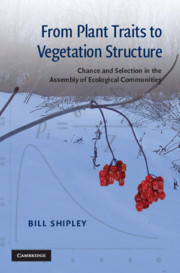 From Plant Traits to Vegetation Structure
From Plant Traits to Vegetation Structure Book contents
- Frontmatter
- Contents
- Preface
- 1 Playing with loaded dice
- 2 Population-based models of community assembly
- 3 Trait-based community ecology
- 4 Modeling trait-based environmental filters: Bayesian statistics, information theory and the Maximum Entropy Formalism
- 5 Community dynamics, natural selection and the origin of community-aggregated traits
- 6 Community assembly during a Mediterranean succession
- 7 The statistical mechanics of species abundance distributions
- 8 Epilogue: traits are not enough
- References
- Index
3 - Trait-based community ecology
Published online by Cambridge University Press: 05 June 2012
- Frontmatter
- Contents
- Preface
- 1 Playing with loaded dice
- 2 Population-based models of community assembly
- 3 Trait-based community ecology
- 4 Modeling trait-based environmental filters: Bayesian statistics, information theory and the Maximum Entropy Formalism
- 5 Community dynamics, natural selection and the origin of community-aggregated traits
- 6 Community assembly during a Mediterranean succession
- 7 The statistical mechanics of species abundance distributions
- 8 Epilogue: traits are not enough
- References
- Index
Summary
When you look at vegetation, you can concentrate on the things you see (plants or species) or on the properties of these things (the traits of plants). As the previous chapter has emphasized, most ecologists working at the population and community levels have concentrated on the things, not their properties, and, because of this conceptual framework, the process of community assembly has usually been seen as a demographic one. Despite this majority tradition there has always been, even from the beginnings of plant ecology as a scientific discipline, two minority approaches in the study of plant communities. The first minority approach, used especially by plant geographers, concentrated on morphological properties of plants and how, on average, such morphologies change as a function of major climatic variables such as temperature and precipitation (Warming and Vahl 1909, DuRietz 1931, Raunkiaer 1934, Holdridge 1947, Box 1981, 1995, 1996). In fact Warming, who can reasonably be called the father of plant ecology, had an explicitly trait-based approach. A small group of American prairie ecologists applied this approach to the regional, rather than the global, scale during the first half of the twentieth century but without much impact on community ecology (Steiger 1930, DuRietz 1931, Dykserhuis 1949, Knight 1965). A second minority approach is based on the notion of ecological “strategies” (Southwood 1977). Grime's CSR scheme (Grime 1974, 1977) is perhaps best known to contemporary plant ecologists but Grime (2001, page 5) documents a continuous history dating back to MacLeod (1894).
- Type
- Chapter
- Information
- From Plant Traits to Vegetation StructureChance and Selection in the Assembly of Ecological Communities, pp. 36 - 81Publisher: Cambridge University PressPrint publication year: 2009


